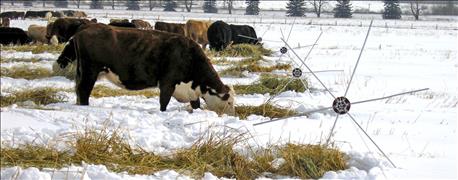November 4, 2016

Sandy Smart, South Dakota State University professor and Extension rangeland grazing management specialist, can explain the math that makes swath grazing a good way to cut winter feed costs.
Swath grazing involves cutting forage and laying it in a swath. But rather than baling the swath, you turn cattle out into the field.
Grazing is an inefficient process during the growing season, when residual leaf material is needed to maintain plant vigor, Smart says. But after a plant sets seed or after a killing frost, grazing becomes an efficient and effective tool.

HARVESTING FORAGE: Cows find hay lying in a swath beneath the snow.
"At this point in the growing season, less residual leaf material is needed to ensure plant vigor, and therefore, a greater grazing pressure can be applied to increase the harvest efficiency," Smart says.
Harvest efficiency may increase as much as 50% under very heavy stocking rates or grazing pressures that approach 50 animal unit days.
By contrast, harvest efficiency could be as high as 80% with haying, depending on the cutting height.
Combining the advantages of these two techniques (high harvest efficiency of cutting and low labor costs of grazing) is the underlying principle behind swath grazing.
Harvest efficiency of swath grazing can be calculated by multiplying the efficiency at harvesttime by the efficiency of grazing the swaths in the fall and winter.
If you assumed 80% harvest efficiency at cutting and 75% efficiency during the grazing of the swaths, you would realize a 60% overall harvest efficiency (80% x 75%).
Strip grazing the swaths — turning cattle out on one swath at a time — can reduce waste and increase swath grazing even more, Smart says.
How it works
On an operation that Smart studied, the producer spends about half an hour per day moving the temporary electric fence to give the cattle access to new swaths.
"Feeding hay using round bales would take a similar amount of time but would also include the costs of running the tractor. Therefore, the producer is eliminating the costs associated with baling and bale moving portions of the haying enterprise."
To implement swath grazing, you need to figure out how to get water to the cattle. You also need to test the nutrient content of swaths so you can figure out which supplements are needed. Most likely, some level of protein supplement will be required, Smart says.
Source: SDSU
You May Also Like




